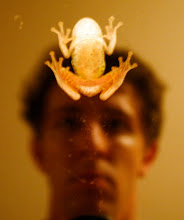This is the first illustration I've finished in a long time. I'm hoping to break the hiatus by following this piece up with a couple of others in the coming two weeks, but we'll see.
I've posted below some of the process in its making, including the ink on acetate drawing, watercolor, an alternate coloring, and final touched up digitally (which is first.) The piece is approximately 8 x 10" (because my scanner can't accommodate much larger).
Final.
The idea for this piece appeared to me one night as I was driving home from a friend's house and noticed the moonlight spilling across a field.
I was nearly done with the piece before I realized that I was likely drawing subconsciously from an illustration in a book that I often read as a child. The book was published by Reader's Digest in South Africa (where I grew up until I was seven). It was a book of children's stories called: "The World's Best Fairy Tales." When I open the book now (I found it in my parent's basement) it falls open to the page with the illustration that so fascinated me. The illustration, pictured below, used to frighten the hell out of me for reasons I have trouble articulating now.
It depicted a scene from the story "Ntombinde Who Loved Adventure," a tale which to me defies categorization and analysis from Western standards. When re-reading the story today I thought at first it had a chauvinistic agenda, but by the end decided it was empowering in its feminism.
The story tells of a rebellious young Zulu woman who seeking adventure, ventures into the world and manages to get her village eaten by a monster for the reckless disobedience of her father. After everyone is freed by a crafty huntsman from the belly of the beast, Ntombinde's father makes her promise not to do any more adventuring and to settle down and marry. Ntombinde thwarts her father's intentions once more by agreeing to marry only if she can choose her husband (apparently an unusual request).
Ntombinde chooses the Snake Man who lives in a village nearby, a creature whom everyone fears. By her fearless acceptance of him as her husband despite his slithery form, Ntombinde breaks the curse on her soon-to-be-spouse. The Snake Man had been transformed into a serpent by his jealous brothers, as he was to take his father's place as chief. Ntombinde then marries the Snake-man-turned-handsome-chief and lives a happy, wealthy life. I have trouble drawing a single moral from the narrative, but the message seems to be: fate will reward those who are courageous and persevere despite initial obstacles.
Anyway, it wasn't the story that interested me when I was younger- it was the illustration. I think to a large extent the bizarre dentistry of the beast disturbed me- the ratio of gums to teeth seems disproportionate. There's no real point in analyzing the illustration's effect on me since quite nearly everything had the potential to scare me when I was younger. Still, I was amazed that it should find its way into some of my work.
I was listening to a radio program (actually a podcast) called Big Ideas- a Canadian produced (TVO) lecture series that's well worth investigating- it's on iTunes. The speaker of this particular episode Cory Doctorow, was arguing for the continued publication of books despite the seeming trend toward digitized versions of books and infringing copyright laws. His rationalization seemed overly romantic (and frankly, materialistic) to me at first listen, but after finding "The World's Best Fairy Tales" in the basement, smelling its pages and reminiscing with my gran I have definitely changed my mind.
I wish for everyone to find a crappy old book they can leaf through and rekindle some childhood fear or fantasy.







No comments:
Post a Comment